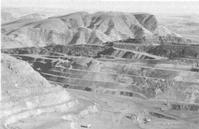


Chapter 10
I 1. Introduction
II 2. The Role Of Technology
III 3. Some Highlights Of Australian Minerals Technology
i Gold
ii Copper
iii Lead-zinc-silver
iv Technology in iron ore mining
v Iron and steel technology
vi Nickel
vii Mineral sands
viii Bauxite, alumina, aluminium
IV 4. Other Technological Achievements (in brief)
V 5. Export Of Technology
VI 6. Education And Research
VII 7. The Scientific Societies
VIII 8. Conclusion
References
Index
Search
Help
Contact us

The major deposits currently developed and the installed production capacities of the respective operations include:
- Mt Tom Price and Paraburdoo
-Hamersley Iron (46 Mt/a) - Mt Whaleback
-Mt Newman Mining (40 Mt/a) - Deepdale Limonite deposits
-Robe River Mining (20 Mt/a) - Shay Gap/Sunrise Hill area
-Goldsworthy Mining Associates (8 Mt/a)
Prospective operations include the Yandicoogina (CRA) and Marillina Creek (BHP) limonite deposits and McCamey's Monster (Hancock/BHP Joint Venture).
In the Brockman deposits large scale conventional open pit mining operations precede three stages of crushing and screening to produce two products, lump (-30+6 mm) and fines (-6 mm). Limonite is sold as an all fines product.
Due to the relatively heterogeneous nature of the orebodies sophisticated selective mining practices and quality control procedures have been developed at each mine site to optimize mining efficiency and to ensure product quality specifications are achieved.
At the time of the commencement of exports (mid 1960s) the market demand was predominantly for lump ore which accounted for approximately 50 percent of output. To minimize excess fines stocks, Hamersley built a plant to convert the fines to a prepared blast furnace feed -pellets. A second plant was commissioned by Cliffs Robe River in 1972 to convert portion of its limonite fines into pellets -a first for the industry. However, the oil price rises of the 1970s and the rapidly advancing technology of Japanese ironmakers established sinter as the preferred blast furnace burden material with the resultant drastic reduction in the use of pellets as a raw material. Pellets are no longer produced in the Pilbara and the idle plants stand as a grim reminder of the effect of changing technology in the steel industry.
Because iron ore is essentially a low priced commodity (1987 price: $Aus23/t FOB), mining, product preparation, rail transportation and shipping operations must be performed on the largest possible scale and with maximum utilization taking full advantage of the best and latest technology to ensure the lowest possible unit cost of production.
Technology trends
The general philosophy adopted by all levels of management is to do things 'smarter' and to maintain a position 'at the cutting edge of technology'.
Technology advances in the mining arena have focussed in the main on the development of large units of plant and equipment (e.g. shovels, trucks, drills, etc.) and the industry has been quick to introduce new models and innovations. In the areas of fixed plant, transportation and port operations the emphasis has been on improvements in such things as
- wear resistant materials
- maintenance planning and procedures
- process control through use of computers
- quality control techniques
- improved communications
- automation and so on
During the short history of the Pilbara iron ore industry there have been numerous examples of major technological innovations on the part of the industry itself and of companies working in conjunction with equipment manufacturers to adapt the results of advanced and developing technology to best suit local conditions.

Organisations in Australian Science at Work - Goldsworthy Mining Associates; Hamersley Iron; Mount Newman Mining Co. Pty Ltd; Mount Tom Price Mine, W.A.; Paraburdoo Power Station, W.A.
 |
Australian Academy of Technological Sciences and Engineering |  |
© 1988 Print Edition pages 753 - 754, Online Edition 2000
Published by Australian Science and Technology Heritage Centre, using the Web Academic Resource Publisher
http://www.austehc.unimelb.edu.au/tia/718.html